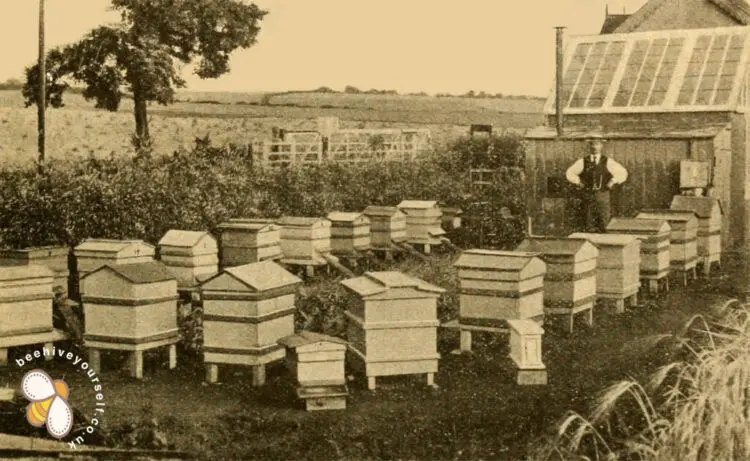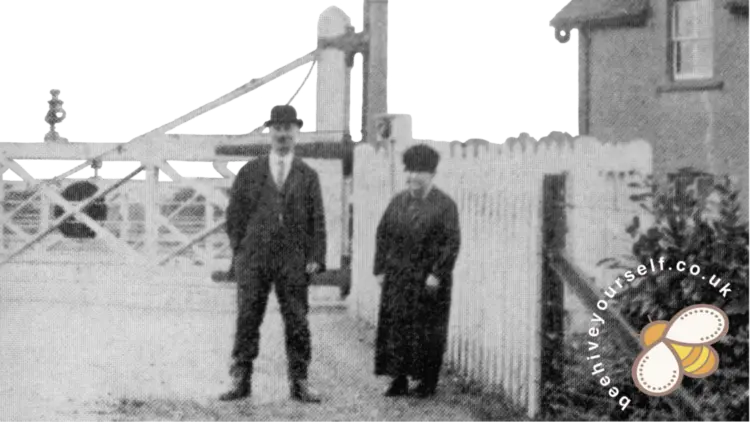Every so often I discover an apiary at a surprising location, and one such place, albeit in a photograph, was in the back garden of a railway-crossing cottage at Compton, Berks. This article tells the story of C W Dyer and his wife Sarah, their beekeeping activities, and the railway which served the Berkshire Downs. I finish by considering why Charles Dyer was able to adopt the modern version of the beekeeping, when so many in the countryside were abandoning the craft.

Mr Dyer sets the scene in a letter he wrote to British Bee Journal in 1905:
‘I purchased my first swarm in 1893, after having made my first hive from used boxes; this is the second one on the right of your humble servant in the picture. From that time forward I have made all the hives except the last one, on my left. The first three gave me some trouble in manipulating until I converted them, as I commenced bee-keeping without the aid of any literature whatever, picking up what information I could until I became the possessor of a ‘Guide Book’, which is, to my mind, indispensable to a bee-man. I next joined the County Association, and soon after had a slight attack of bee-fever, since when, with plenty of work, I made very satisfactory progress, ending by having gained my third-class certificate. I purchase the timber and make my hives in winter evenings — one or two each year as time permits, as, of course, all other bee-work has to be done. Seeing that I am away from home working on the railway as a platelayer from 6 a.m. till 6 p.m., and as seen in photo I live at a railway crossing, my better half, in addition to being gate-keeper, is an ideal bee-man’s wife.’ (1)
Life On The Railway
Mr Dyer’s connection with the railway began before it was operational. In 1881 he was living at Hagbourne with his wife and their first child, and was working as a ‘navvy on the railroad’. (2) The construction of the line required vast numbers of men, and scores of railway labourers from all over the country descended onto the village of Upton, near to Didcot. These navvies were either living in makeshift huts, of which there were 12, or in nearby lodgings. (3)
It is unknown whether Mr Dyer migrated into the area to work on the railway, or whether it had something to do with meeting Sarah, his wife, who came from Hagbourne, the nearby village. Charles Dyer, who was the son of an agricultural labourer, had originally come from Wootton, which is about 10 miles from Hagbourne. (4)
The Didcot to Newbury section of the railway opened on 13 March 1882 (5), and meandered through the Berkshire Downs connecting a handful of rural villages. Two years after the railway opened Mr Dyer commenced work on the line, and subsequently his wife also gained employment (6) with what was then the Didcot, Newbury and Southampton Railway Company. (7) Mrs Dyer was the crossing gatekeeper (more on this below) and the cottage, with its ample garden, came with the job. The couple had six children (8), and lived at their railway home for many decades.
Life With The Bees
Based on the entries in the British Bee Journal, it would appear that Mr Dyer began competing in honey shows from 1904 onwards. It could be said he was following in the foot steps of William Woodley by entering sections of honeycomb at the show bench. It is worth noting that Woodley lived just three miles from their cottage as the crow flies, and it is believed that both were friends. In later years, Charles Dyer would win medals at national beekeeping shows for his honey. (9)
Retirement

The Didcot, Newbury and Southampton Railway Company became part of the Great Western Railway in 1923. (10). A 1930 article in the GWR Magazine summarises the Dyer’s working life:
‘The retirement of Mrs Dyer from Compton Crossing, on October 30th 1930, brought to a close a term of long and faithful service with the company. Mrs Dyer’s connection with the crossing went back to the early days of the Didcot, Newbury and Southampton line, for she commenced her duties as crossing keeper two year after the line opened in 1882. There were four gates in those days, and the crossing keeper had to rely entirely on the clock, there being no signals or instruments of any description to assist her. Mrs Dyer remained as crossing keeper there for forty-five years and retired in good health.
Mr Dyer retired in November last year from the permanent way department after forty-five -and-a-half years.’ (11)
In retirement, the former railwayman wrote articles in the Bee-Keepers’ Record, under the title ‘Notes from Mid Hampshire.’ (12). Charles Dyer successfully continued to participate in honey shows until the war broke out: the conflict caused such events to cease across the country. Despite the country being in the midst of a conflict, beekeeping associations’ work continued and at some point during the 1940s he became the President of the Hampshire Beekeeping Association. (13)
The Passing Away Of The Dyers and The Railway; Railway-Crossing Cottage Repurposed.
Sadly Mrs Dyer only lived nine years into her retirement, and died in 1938 (14), whereas her husband passed away in 1946. (15)
A bigger loss was to take place during the 1960s when the railway line was closed. In the summer of 1962, it was announced that the Didcot to Newbury line would close for passenger traffic because it was not economic. (16) As result, two of the six stations, Churn and Pinewood, would close on 16 September of that year, and the other four would be open to accept parcels and to deal with freight business. (17)
The swan song for this railway occurred when the crossing cottage and the adjoining track very briefly appeared in the 1965 film ‘Those Magnificent Men In Their Flying Machines’. (18) It was briefly shown as the backdrop, with a platoon of vintage cars passing by the crossing, on route to a fictional coast. The scene lasts no more than 10 seconds and provides a glimpse, in cinematic colour, of what the Dyers’ old home and environment would have been like.
The railway closed in 1967 (19) and subsequently was dismantled. The railway cottage was sold and exists today as a private dwelling and is called ‘Crossing Cottage’. Whilst it is visible from the roadside, it has lost most of its railway charm. The crossing gates are long gone, with the track-bed filled in and hidden by a lawn. The adjacent road’s strange dogleg around the house is the biggest clue that a railway was once there.
Why Charles Dyer was able to adopt the modern version of the beekeeping, when so many in the countryside were abandoning the craft?
This is an important question to consider because modern beekeeping was envisaged as ‘a means of bettering the condition of cottagers and the agricultural labouring classes’ (20), however these social classes appeared to be the most resistant to embrace it.
Conversely, Mr Dyer adopted modern beekeeping which I believe were for the following reasons.
The Dyer’s home, the railway-crossing cottage, which would have been tied to Mrs Dyer’s job, was located in an isolated part of the countryside with an ample garden. These attributes made it possible for several dozen hives to be located in their back garden without them becoming a nuisance.
In addition, the Dyers had relatively more security of tenure in their jobs, and consequently their home, compared to agricultural labourers. Therefore, the problem of re-homing hives at short notice because they had to move, probably wasn’t a serious consideration.
I also suspect that, Sarah Dyer, nee Fidler, might have been an influence on her husband’s decision to start beekeeping. Mrs Dyer was born in the village of West Hagbourne and would have grown up with various members of the Woodley family, many of whom made their name in modern beekeeping.
In Conclusion – Charles Dyer’s Bees, Railway and Crossing Cottage.
Mr Dyer’s long career with the railway ran along side with his beekeeping activities. Charles Dyer adopted modern bee-keeping and achieved success at the show-bench with his honey. Furthermore, he gained a certain degree of social standing in bee-keeping circles.
What sparked Charles Dyer’s interest in bee-keeping is not known. However, we can say that the railway cottage, courtesy of his wife’s job, provided a home for his family and the location for his apiary. Such circumstances allowed Mr Dyer to adopt modern bee-keeping at a time when many agricultural workers were leaving the countryside and giving up the craft.
The railway, which Mr Dyer helped to build, outlived him by twenty-one years. Today, ‘Crossing Cottage’ stands as a reminder to an earlier railway past in the village, but sadly, Mr Dyer and his bees are mostly forgotten.
More on William Woodley
I will be writing more about William Woodley in the future, and here are some of my other writings about the great man:-
William Woodley – An Introduction
Around William Woodley’s Apiary, Worlds End, Beedon
Christmases At Beedon As Described in Mr Woodley’s Journals
How I researched the Berkshire bee van
Folklore of bees and beekeeping
Endnotes
1 T. W. Cowan & W. Broughton Car, HOMES OF THE HONEYBEE. THE APIARIES OF OUR READERS. British Bee Journal, vol. 33 (21 December1905), 505.
2 1881 census of England, Berkshire, West Hagbourne, Charles W. Dyer household; digital images, Ancestry.com; citing RG11/1292/53/2.
3 1881 census of England, Berkshire, Upton, digital images, Ancestry.com; citing RG11/1290/29-37/13-29.
4 1871 census of England, Berkshire, Wootton, Charles Dyre, digital images, Ancestry.com; citing RG10/1264/76/7.
5 T. B. Sands,The Didcot, Newbury & Southampton Railway,(Lingfield, Surrey:The Oakwood Press, 1971), 49.
6 Rosa Matheson, The Fair Sex: Women and the Great Western Railway, (Stroud : Tempus, 2007), 89-90.
7 T. B. Sands, The Didcot, Newbury & Southampton Railway, 38.
8 1911 census of England, Berkshire, Compton, Charles W. Dyer household; digital images, Ancestry.com; citing RG 14/6502 Sch. 36.
9 Bee-keepers’ Record, 51 (1933), 145.
10 T. B. Sands, The Didcot, Newbury & Southampton Railway, 38.
11 Rosa Matheson, The Fair Sex: Women and the Great Western Railway, 89-90
12 Bee-keepers’ Record, 60 (1942), 162.
13 Bee-keepers’ Record, 63 (1945), 15.
14 Bee-keepers’ Record, 56 (1938), 233.
15 Bee-keepers’ Record, 64 (1946), 81.
16 Newbury Weekly News, DIDCOT LINE CLOSING DATE,Thursday, July 5, 1962.
17 Newbury Weekly News, DIDCOT LINE CLOSING DATE,Thursday, August 30, 1962.
18 Those Magnificent Men In Their Flying Machines [DVD],Director Ken Annakin, 20th Century Fox Home Entertainment1965.
19 T. B. Sands, The Didcot, Newbury & Southampton Railway, 49.
20 Charles Nash Abbott, ‘FORMATION OF THE BRITISH BEE-KEEPERS ASSOCIATION.’ British Bee Journal, vol. 2 (June 1874), 19.


